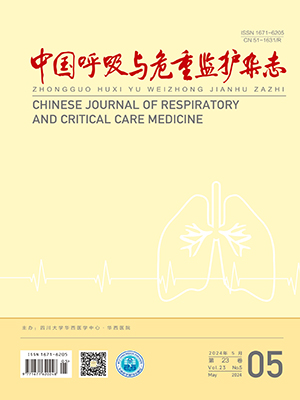| 1. |
Demoly P, Gueron B, Annunziata K, et al. Update on asthma control in five European countries:results of a 2008 survey. Eur Respir Rev,2010,19:150-157.
|
| 2. |
Nathan RA, Sorkness CA, Kosinski M, et al. Development of the asthma control test:a survey for assessing asthma control. J Allergy Clin Immunol,2004,113:59-65.
|
| 3. |
Krasnodębska P, Hermanowicz-Salamon J, Domagała-Kulawik J, et al. Factors influencing asthma course and the degree of control in the patients assessed with own questionnaire and Asthma Control Test (ACT). Pneumonol Alergol Pol,2012,80:198-208.
|
| 4. |
Fletcher M, Hiles D. Continuing discrepancy between patient perception of asthma control and real-world symptoms:a quantitative online survey of 1083 adults with asthma from the UK. Prim Care Respir J,2013,22:431-438.
|
| 5. |
颜文森,郑劲平,高怡,等.动态肺功能测试与哮喘控制测试不同症状感知类型支气管哮喘患者的相关性研究.实用医院临床杂志,2013,10:19-22.
|
| 6. |
British Thoracic Society/Scottish Intercollegiate Guidelines Network. British guideline on the management of asthma. A national clinical guideline. http://www.sign.ac.uk/guidelines/fulltext/101/index.html (accessed August 2012).
|
| 7. |
Pedersen S. From asthma severity to control:a shift in clinical practice. Prim Care Respir J,2010,19:3-9.
|
| 8. |
Pedersen SE, Bateman ED, Bousquet J, et al. Determinants of response to fluticasone propionate and salmeterol/fluticasone propionate combination in the Gaining Optimal Asthma ControL study. J Allergy Clin Immunol,2007,120:1036-1042.
|
| 9. |
Demoly P, Annunziata K, Gubba E, et al. Repeated cross-sectional survey of patient-reported asthma control in Europe in the past 5 years. Eur Respir Rev,2012,21:66-74.
|
| 10. |
Janssens T, Verleden G, Van den Bergh O. Symptoms, lung function, and perception of asthma control:an exploration into the heterogeneity of the asthma control construct. J Asthma,2012,49:63-69.
|
| 11. |
Reddel HK, Taylor DR, Bateman ED, et al. An official American Thoracic Society/European Respiratory Society statement:asthma control and exacerbations:standardizing endpoints for clinical asthma trials and clinical practice. Am J Respir Crit Care Med,2009,180:59-99.
|
| 12. |
Demoly P, Paggiaro P, Plaza V, et al. Prevalence of asthma control among adults in France, Germany, Italy, Spain and the UK. Eur Respir Rev,2009,18:105-112.
|
| 13. |
Partridge MR, Dal Negro RW, Olivieri D. Understanding patients with asthma and COPD:insights from a European study. Prim Care Respir J,2011,20:315-323.
|
| 14. |
Hsu JY, King SL, Kuo BI, et al. Age of onset and the characteristics of asthma. Respirology,2004,9:369-372.
|
| 15. |
DeFrances CJ, Lucas CA, Buie VC, et al. 2006 National Hospital Discharge Survey. Natl Health Stat Report,2008,5:1-20.
|
| 16. |
Bashoura L, Hanania NA. Confronting the challenges of asthma in the elderly patient:cough may be the only presenting symptom. J Resp Dis,2004,25:310-316.
|
| 17. |
Braman SS, Hanania NA. Asthma in older adults. Clin Chest Med,2007,28:685-702.
|
| 18. |
Kavut AB, Kalpakloglu AF. Impact of asthma education meeting on asthma control level assessed by Asthma Control Test. WAO J,2010,3:6-8.
|
| 19. |
Clatworthy J, Price D, Ryan D, et al. The value of self-report assessment of adherence, rhinitis and smoking in relation to asthma control. Prim Care Respir J,2009,18:300-305.
|
| 20. |
Federman AD, Sano M, Wolf MS, et al. Health literacy and cognitive performance in older adults. J Am Geriatr Soc,2009,57:1475-1480.
|
| 21. |
Massanari M, Holgate ST, Busse WW, et al. Effect of omalizumab on peripheral blood eosinophilia in allergic asthma. Respir Med,2010,104:188-196.
|
| 22. |
Wagener AH, Nijs SB de, Lutter R, et al. External validation of blood eosinophils, FE(NO) and serum periostin as surrogates for sputum eosinophils in asthma. Thorax,2015,70:115-120.
|
| 23. |
Zeiger RS, Schatz M, Li QW, et al. High blood eosinophil count is a risk factor for future asthma exacerbations in adult persistent asthma. J Allergy Clin Immunol Pract,2014,2:741-750.
|
| 24. |
Skiepko R, Ziętkowski Z, Łukaszyk M. Changes in blood eosinophilia during omalizumab therapy as a predictor of asthma exacerbation. Postepy Dermatol Alergol,2014,31:305-309.
|




